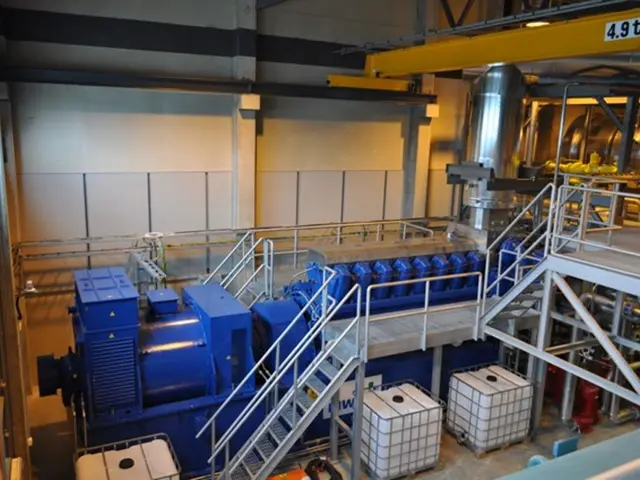AI-driven Workforce Evolution: The Labor Advancement in the Artificial Intelligence Age
In a significant shift, unions are adapting their approach to labor advocacy, recognising the potential of artificial intelligence (AI) to both empower and displace workers. This transformation is evident in various strategies and adaptations, as unions negotiate enforceable agreements, provide training, and advocate for national regulation.
Mandatory Consultations and AI Implementation Agreements
Unions are demanding that employers consult them before deploying AI, ensuring worker involvement and protections around job impact, retraining, and data privacy. This proactive engagement aims to balance the need for technological advancement with the need to safeguard workers' rights and job security.
Training and Worker Development
Recognising AI as a tool to enhance, rather than replace, human roles, unions are providing training for employees to harness AI technologies. This focus on augmentation over displacement is a key strategy in the union's approach to AI.
Collaborative Bodies and Bargaining Provisions
Some unions are pushing for committees or cross-functional working groups to monitor AI developments and guide responsible adoption. They are also seeking explicit contract language limiting AI application without consent and ensuring new policies apply prospectively.
National Regulation and Oversight
Unions are calling for a national AI authority and legislation to keep pace with AI's fast evolution, providing a legal framework that enforces worker rights and ethical AI uses in workplaces. This demand for regulation reflects the unions' commitment to shaping AI's role in the workplace positively.
Beyond Unions: A Culture of Continuous Learning
Companies and organisations are also fostering AI adaptability by promoting continuous learning cultures, appointing AI champions, and involving multi-disciplinary teams to guide ethical AI implementation. This complements union efforts to integrate AI responsibly and focus on human-AI collaboration.
The Future of Labor Advocacy
The labor movement's vision of worker-centered digital change may represent the future of labor advocacy. By focusing on ensuring workers can thrive alongside technology through strategic upskilling initiatives and collective bargaining for technology transition rights, unions are positioning themselves as key players in technological progress that truly serves human flourishing rather than mere economic efficiency.
Digital Learning Initiatives
Large service sector unions have established peer-to-peer digital skills programs for mentorship and training. Additionally, unions are advocating for universal broadband access, community-based digital skills programs, technology access initiatives for underserved populations, and public library modernization as digital learning centers.
The Pace of Technological Transformation
The pace of technological transformation is compressing adaptation timeframes, requiring more responsive approaches to workforce development. Unions are responding to this challenge by developing digital readiness assessment tools to help members identify their specific development needs and by creating targeted upskilling programs for members most at risk of displacement.
In summary, unions are evolving from reactive opposition to AI towards proactive engagement. They are negotiating legally binding frameworks, securing developmental support for workers, and demanding transparency and oversight to shape AI's role in the workplace positively. This shift in approach underscores the unions' commitment to ensuring workers benefit from the opportunities presented by AI, rather than being left behind by technological advancement.
[1] Union Adapts to AI Challenges: A Case Study
[2] AI and the Future of Work: A Comprehensive Review
[3] AI Implementation Agreements: A Union Perspective
[4] The Role of Unions in AI Adaptation: A Roundtable Discussion
- Unions are advocating for mandatory consultations before employers deploy AI, seeking to secure protections for workers' rights and job security, as well as involvement in decisions that impact their jobs.
- In response to AI's potential to enhance human roles, unions are offering training programs to help employees harness AI technologies and adapt to technological advancements.
- Union representatives are pushing for the creation of collaborative bodies, such as committees or cross-functional working groups, to oversee AI developments and ensure their responsible adoption within workplaces.
- Unions are campaigning for national regulations on AI, including the establishment of an AI authority, to keep up with the fast-paced evolution of technology and to provide a legal framework that protects workers' rights and promotes ethical AI in the workplace.
- Companies and organizations are complementing union efforts by promoting continuous learning cultures, appointing AI champions, and using multi-disciplinary teams to guide ethical AI implementation, focusing on human-AI collaboration.
- To address the compressed adaptation timeframes caused by the pace of technological transformation, unions are developing digital readiness assessment tools, targeted upskilling programs, and advocating for digital learning initiatives like universal broadband access and community-based programs to equip workers with the necessary skills.




